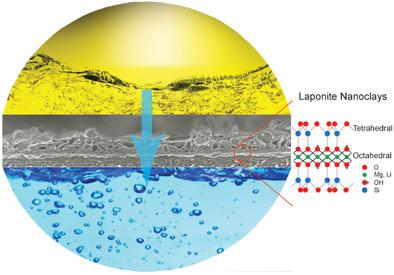当前位置:
X-MOL 学术
›
Adv. Mater. Interfaces
›
论文详情
Our official English website, www.x-mol.net, welcomes your
feedback! (Note: you will need to create a separate account there.)
Nanoclays‐Incorporated Thin‐Film Nanocomposite Membranes for Reverse Osmosis Desalination
Advanced Materials Interfaces ( IF 4.3 ) Pub Date : 2020-02-26 , DOI: 10.1002/admi.201902108 Qipeng Zhao 1 , Die Ling Zhao 1 , Tai‐Shung Chung 1
Advanced Materials Interfaces ( IF 4.3 ) Pub Date : 2020-02-26 , DOI: 10.1002/admi.201902108 Qipeng Zhao 1 , Die Ling Zhao 1 , Tai‐Shung Chung 1
Affiliation

|
A series of thin‐film nanocomposite (TFN) membranes with incorporation of Laponite nanoclays (NC‐LAP) is prepared and demonstrated for brackish water and seawater desalination. It is the first attempt to use poly(ethylene glycol) 200 (PEG200) assisted Laponite as nanofillers to improve the performance of TFN membranes for reverse osmosis (RO) seawater desalination. The influence of NC‐LAP loading and PEG200 as the dispersant on membrane properties is investigated. An increase in NC‐LAP loading results in an increase in water permeability without sacrificing the salt rejection. At the loading of 0.3 wt%, the TFN membrane shows a water permeability of 2.7 L m−2 h−1 bar−1 (LMH bar−1) and a salt rejection of 98.18% for brackish water desalination at 20 bar and 25 ± 1 °C. This water permeability is 53% higher than the conventional thin‐film composite (TFC) membrane. A steady water flux above 35 LMH is obtained when using seawater as the feed at 50 bar and 25 ± 1 °C. The existence of PEG200 to effectively disperse NC‐LAP nanoparticles is essential to fabricate the NC‐LAP incorporated TFN membranes for brackish water and seawater desalination.
中文翻译:

纳米粘土结合的薄膜纳米复合膜用于反渗透淡化
制备了一系列结合了Laponite纳米粘土(NC-LAP)的薄膜纳米复合材料(TFN)膜,并证明了其可用于咸水和海水淡化。这是首次尝试使用聚乙二醇200(PEG200)辅助的Laponite作为纳米填料来提高TFN膜在反渗透(RO)海水淡化中的性能。研究了NC‐LAP负载量和PEG200作为分散剂对膜性能的影响。NC‐LAP负荷的增加会导致水渗透率的增加,而不会牺牲盐分。在含量为0.3 wt%的情况下,TFN膜的透水性为2.7 L m -2 h -1 bar -1(LMH bar -1)和在20 bar和25±1°C的咸淡水脱盐率达98.18%。这种水的渗透性比传统的薄膜复合(TFC)膜高53%。当在50 bar和25±1°C下使用海水作为进料时,可获得高于35 LMH的稳定水通量。有效地分散NC‐LAP纳米颗粒的PEG200的存在对于制造用于咸水和海水淡化的NC‐LAP掺入的TFN膜至关重要。
更新日期:2020-02-26
中文翻译:

纳米粘土结合的薄膜纳米复合膜用于反渗透淡化
制备了一系列结合了Laponite纳米粘土(NC-LAP)的薄膜纳米复合材料(TFN)膜,并证明了其可用于咸水和海水淡化。这是首次尝试使用聚乙二醇200(PEG200)辅助的Laponite作为纳米填料来提高TFN膜在反渗透(RO)海水淡化中的性能。研究了NC‐LAP负载量和PEG200作为分散剂对膜性能的影响。NC‐LAP负荷的增加会导致水渗透率的增加,而不会牺牲盐分。在含量为0.3 wt%的情况下,TFN膜的透水性为2.7 L m -2 h -1 bar -1(LMH bar -1)和在20 bar和25±1°C的咸淡水脱盐率达98.18%。这种水的渗透性比传统的薄膜复合(TFC)膜高53%。当在50 bar和25±1°C下使用海水作为进料时,可获得高于35 LMH的稳定水通量。有效地分散NC‐LAP纳米颗粒的PEG200的存在对于制造用于咸水和海水淡化的NC‐LAP掺入的TFN膜至关重要。











































 京公网安备 11010802027423号
京公网安备 11010802027423号